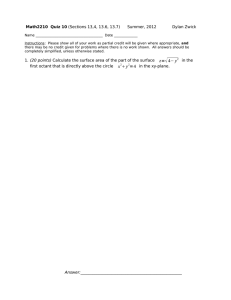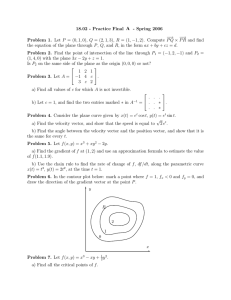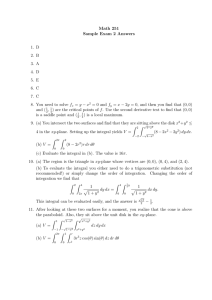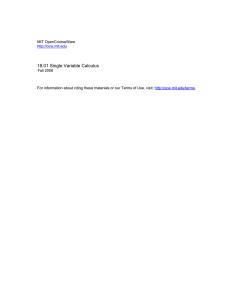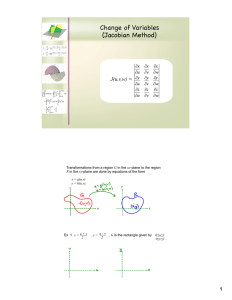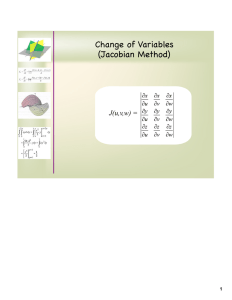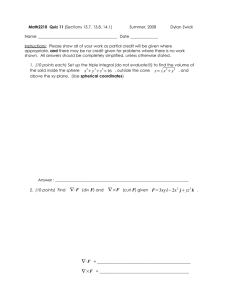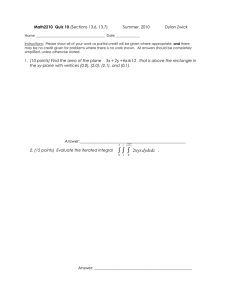18.02 Practice Final 3hrs.
advertisement
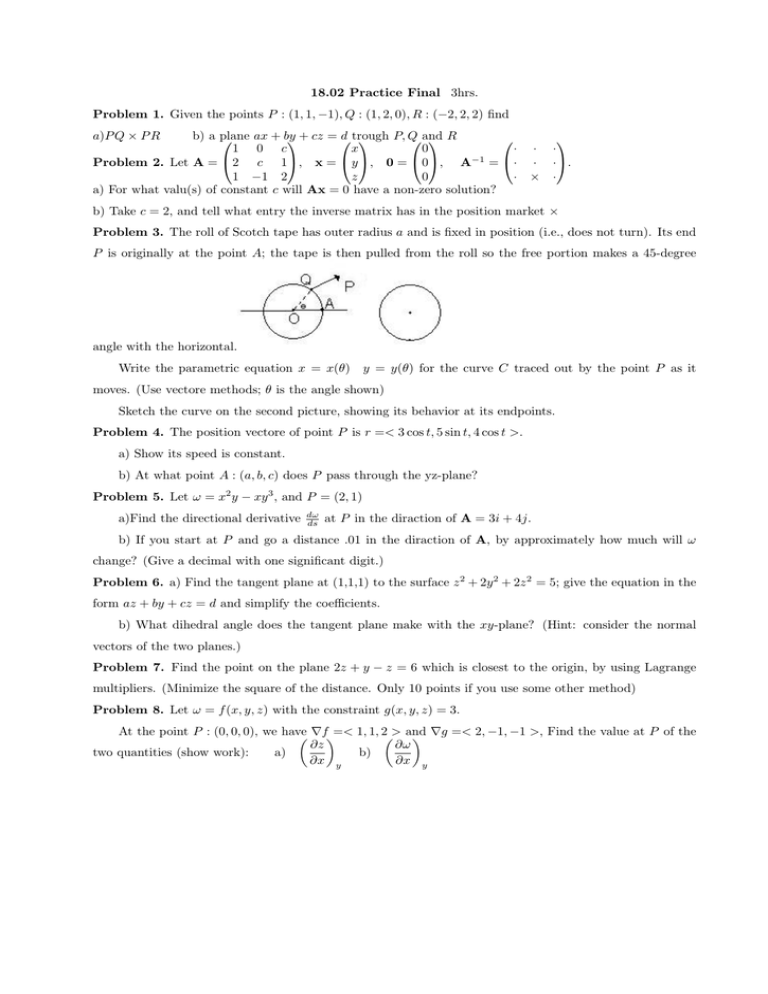
18.02 Practice Final 3hrs. Problem 1. Given the points P : (1, 1, −1), Q : (1, 2, 0), R : (−2, 2, 2) find a)P Q × P R b) a plane ax + by d trough P, Q ⎛ ⎛ ⎞+ cz = ⎛ ⎞ ⎛and ⎞ R ⎞ · · · 1 0 c x 0 Problem 2. Let A = ⎝2 c 1⎠, x = ⎝y ⎠, 0 = ⎝0⎠, A−1 = ⎝· · ·⎠. 1 −1 2 z 0 · × · a) For what valu(s) of constant c will Ax = 0 have a non-zero solution? b) Take c = 2, and tell what entry the inverse matrix has in the position market × Problem 3. The roll of Scotch tape has outer radius a and is fixed in position (i.e., does not turn). Its end P is originally at the point A; the tape is then pulled from the roll so the free portion makes a 45-degree angle with the horizontal. Write the parametric equation x = x(θ) y = y(θ) for the curve C traced out by the point P as it moves. (Use vectore methods; θ is the angle shown) Sketch the curve on the second picture, showing its behavior at its endpoints. Problem 4. The position vectore of point P is r =< 3 cos t, 5 sin t, 4 cos t >. a) Show its speed is constant. b) At what point A : (a, b, c) does P pass through the yz-plane? Problem 5. Let ω = x2 y − xy 3 , and P = (2, 1) a)Find the directional derivative dω ds at P in the diraction of A = 3i + 4j. b) If you start at P and go a distance .01 in the diraction of A, by approximately how much will ω change? (Give a decimal with one significant digit.) Problem 6. a) Find the tangent plane at (1,1,1) to the surface z 2 + 2y 2 + 2z 2 = 5; give the equation in the form az + by + cz = d and simplify the coefficients. b) What dihedral angle does the tangent plane make with the xy-plane? (Hint: consider the normal vectors of the two planes.) Problem 7. Find the point on the plane 2z + y − z = 6 which is closest to the origin, by using Lagrange multipliers. (Minimize the square of the distance. Only 10 points if you use some other method) Problem 8. Let ω = f (x, y, z) with the constraint g(x, y, z) = 3. At the point P : (0, 0, 0), we have � �f�=< 1, 1, 2�> and � �g =< 2, −1, −1 >, Find the value at P of the ∂z ∂ω two quantities (show work): a) b) ∂x y ∂x y � 3 � 9 Problem 9. Evaluate by changing the order of integration: 0 2 xe−y dydz. z3 Problem 10. A plane region R is bounded by four semicircles of radius 1. having ends at (1, 1), (1, = 1), (−1, 1), (−1, −1) and centerpoints at (2, 0), (−2, 0), (0, 2), (0, −2). Set up an iterated integral in polar coordinates for the moment of inertia of R about the origin; take the density δ = 1. Supply integrand and limits, but do not evaluate the integral. Use symmetry to simplify the limits of integration. Problem 11. a) In the xy-plane, let F = P i + Qj. Give in terms of P and Q the line integral representing the flux F across a simple closed curve C, with outward-pointing normal. b) Let F = axi + byj. How should the constants a and b be related if the flux of F over any simple closed curve C is equal to the area inside C? Problem 12. A solid hemisphere of radius 1 has its lower flat base on the xy-plane and center at the origin. Its density function is δ = � z. Find the force of gravitational attraction it exerts on a unit mass at the origin. Problem 13. Evaluate (y − x)dz + (y − z)dz over the line segment C from P : (1, 1, 1) to Q : (2, 4, 8). C Problem 14. a) Let F = ay 2 i + 2y(x + z)j + (by 2 + z 2 )k. For what values of the constants a and b will F be conservative? Show work. b) Using these values, find a function f (x, y, z) such that F = �f . � Q F · dr = 0 for any two c) Using these values, give the equation of a surface S having the property : P points P and Q on the surface S. Problem 15. Let S be the closed surface whose bottom face B is the unit disc in the xy-plane and whose upper surface is the paraboloid z = 1 − x2 − y 2 , z ≥ 0. Find the flux of F = xi + yj + zk across U by using the divergence theorem. Problem 16. Using the data of the preceding problem, calculate the flux of F across U directly, by setting up the surface integral for the flux and evaluating the resulting double integral in the xy-plane. Problem 17. An xz-cylinder in 3-space is a surface given by an equation f (x, z) = 0 in x and z alone; its section by any plane y = c perpendicular � to the y-axis is always the same xz-curve. Show that if F = z 2 i + y 2 j + xzk then F · dr = 0 for any simple closed curve C lying on an xz-cylinder. C (Use Stokes’ theorem) � � ∞ 2 −x2 Problem 18. e dx is not elementary but I = e−x dx can still be evaluated. 0 � ∞� ∞ 2 2 a) Evaluate the iterated integral e−x e−y dydx, in terms of I. 0 0 b) Then evaluate the integral in (a) by switching to polar coordinates. Comparing the two evaluations, what value do you get for I? MIT OpenCourseWare http://ocw.mit.edu 18.02SC Multivariable Calculus Fall 2010 For information about citing these materials or our Terms of Use, visit: http://ocw.mit.edu/terms.
